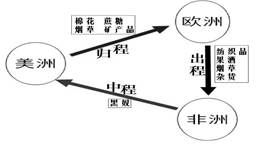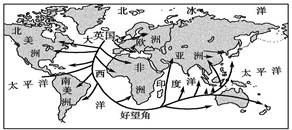阅读下列材料,回答问题。(20分)
材料一:三角贸易示意图。

材料二:19世纪后期英国海外贸易示意图:

材料三:1914资本主义列强瓜分世界领土

材料四 我们原来打算直接用无产阶级国家的法令,在一个小农国家里按 * * 主义原则来调整国家的生产和产品分配。现实生活说明我们犯了错误。
——《列宁选集》卷四
请回答:
(1)根据材料一、二、三并结合所学知识,简述资本主义世界市场的形成经过。(6分)
(2)从材料一到材料三并结合所学知识分析,资本主义殖民侵略方式发生了怎样的变化?(6分)
(3)根据材料一、二、三并结合所学知识,促使资本主义世界市场形成的因素有哪些?(4分)
(4)材料三中列宁的初衷与现实为什么会发生矛盾?(2分)苏俄是怎样解决这一矛盾的?(2分)
(1)新航路开辟,世界各地的文明日益连成一个整体,世界市场的雏形开始出现;(2分)。
第一次工业革命推动世界联系进一步加强,19世纪中后期,以欧美资本主义 列强为主导的资本主义世界市场基本(或初步)形成;(2分)
第二次工业革命推动下列强掀起了瓜分世界的狂潮,19世纪末20世纪初,资本主义世界市场最终形成。(2分)
(2)早期:抢掠、欺诈、种族灭绝、贩卖黑奴等野蛮的资本原始积累方式;(2分)
第一次工业革命后:抢占倾销商品的市场和原料;(2分)
第二次工业革命后:在继续商品输出的同时,以资本输出为主要侵略方式。(2分)
(3)资本的开放与扩张的本性;(1分)新航路的开辟;(1分)殖民侵略扩张;(1分)工业革命的推动。(1分)
(4)矛盾:列宁初衷是通过战时 * * 主义政策使苏俄直接过渡到社会主义,但忽视了当时落后的生产力状况。(2分)
解决:实行新经济政策。(2分)
题目分析:(1)本题主要考查资本主义世界市场的形成过程。回答时,首先要注意三则材料中的示意图的内容及其所反映的时代特点,其次需要注意三则材料的具体内容。材料一是新航路开辟后,资本主义世界市场出现雏形;材料二是在第一次工业革命的影响下,本主义世界市场初步形成;材料三则是在第二次工业革命的影响下,资本主义世界市场最终形成。
(2)本题主要考查在资本主义世界市场的形成过程中,列强对外侵略、掠夺方式的变化。回答时,首先要注意三则材料中的示意图的内容及其所反映的时代特点,其次需要注意三则材料的具体内容。材料一是新航路开辟后,殖民者对外掠夺的特点就是赤裸裸的抢劫与罪恶的黑奴贸易;材料二是在第一次工业革命的影响下,转向商品输出和强占市场、原料产地;材料三则是在第二次工业革命的影响下,瓜分世界,进行资本输出。这样。资本主义世界市场最终形成。
(3)本题主要考查资本主义世界市场形成的原因。回答此题主要从以下几个方面考虑:一是前提条件,即新航路的开辟;二是方式,即殖民侵略与扩张;三是经济因素,资本主义工业革命的影响;四是资本主义本身所具有的特点。同时要注意用词要恰当,语言简洁等。
(4)本题主要考查苏俄经济政策的发展变化。首先要理解材料的含义,列宁大胆地承认实行战时 * * 主义政策作为项 * * 主义过渡到尝试是不成功的,为此果断进行经济政策的调整。反映了列宁从实际出发,事实求是地分析解决问题的马克思主义的态度。适应当时苏俄社会生产力发展的实际情况,实行新经济政策并取得巨大成效。
